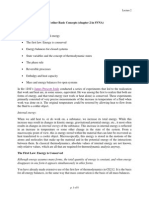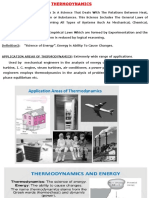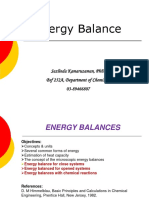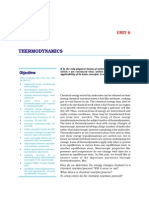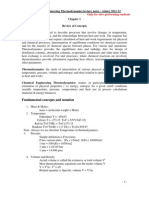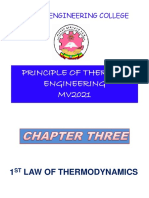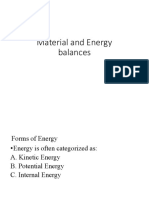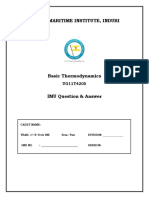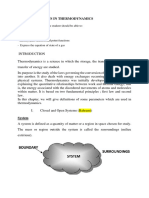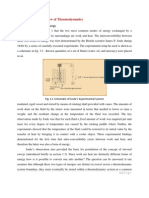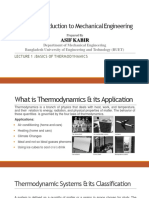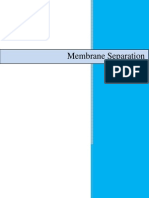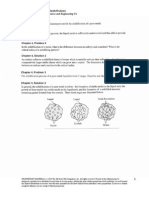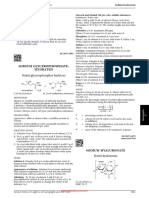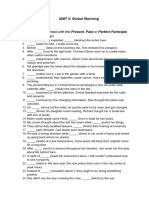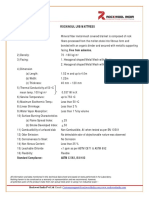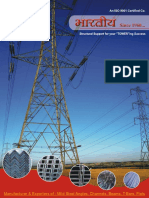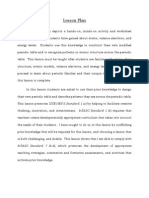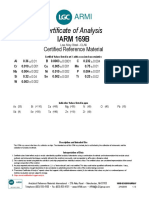Material Chap 7
Material Chap 7
Uploaded by
chemicaly12Copyright:
Available Formats
Material Chap 7
Material Chap 7
Uploaded by
chemicaly12Original Description:
Copyright
Available Formats
Share this document
Did you find this document useful?
Is this content inappropriate?
Copyright:
Available Formats
Material Chap 7
Material Chap 7
Uploaded by
chemicaly12Copyright:
Available Formats
CBE2124, Levicky
Chapter 7 Energy and Energy Balances
The concept of energy conservation as expressed by an energy balance equation is central to chemical engineering calculations. Similar to mass balances studied previously, a balance on energy is crucial to solving many problems. ________________________________________________________________ System A system is an object or a collection of objects that an analysis is done on. The system has a definite boundary, called the system boundary, that is chosen and specified at the BEGINNING of the analysis. Once a system is defined, through the choice of a system boundary, everything external to it is called the surroundings. All energy and material that are transferred out of the system enter the surroundings, and vice versa. In the general case there are very few restrictions on what a system is; a system can have a nonzero velocity, a nonzero acceleration, and a system can even change in size with time. An isolated system is a system that does not exchange heat, work, or material with the surroundings. If heat and work are exchanged across a systems boundary, but material is not, it is a closed system. An open system can exchange heat, work, and material with the surroundings.
Examples. Discuss each situation below as approximating an isolated, a closed, or an open system. (i) A river. (ii) The interior of a closed can of soda. (iii) The interior of a closed refrigerator that is turned on. (iv) The interior of a closed refrigerator that is turned off.
CBE2124, Levicky
State of a System Once a system is defined, a certain number of variables will specify its state fully. For example, one may need to provide the temperature, pressure, composition, total amount of material, velocity, and position in order to specify a systems state. The exact information that is needed to specify the state of a system depends on the type of system and the analysis to be performed. State Functions and State Properties The state of a system can be changed, for example by increasing its temperature or changing its composition. Properties of the system whose change depends only on the initial (before) and final states of the system, but not on the manner used to realize the change from the initial to the final state, are referred to as state properties or state functions. In other words, the change in a state function or state property X, between some final (state 2) and initial (state 1) situations, can be expressed as
X = X final X initial X state 2 X state 1 14 4 244 3
change in X
(1)
In equation 1, Xfinal only depends on the final state of the system, and Xinitial only on the initial state of the system. Equation 1 does not require any information whatsoever as to how the system got from the initial to the final state, since X does not depend on the details of the path followed. Example. Which of the below examples represent changes in state functions? (i) Work done to climb from the bottom (state 1) to the top (state 2) of a mountain. Change in gravitational energy of an object when it is raised from the bottom (state 1) to the top (state 2) of a mountain. Change in density of water in a pot when it is heated from 20 oC (state 1) to 50 oC (state 2). Amount of heat liberated from burning gas in a stove in order to realize a temperature change of the water in a pot from 20 oC (state 1) to 50 oC (state 2). (This requires some thought )
(ii)
(iii)
(iv)
CBE2124, Levicky
Forms of Energy: The First Law of Thermodynamics Energy is often categorized as: A. Kinetic Energy B. Potential Energy C. Internal Energy Kinetic Energy A systems kinetic energy is associated with directed motion (e.g. translation, rotation) of the system. Translation refers to straight line motion. The kinetic energy Ek of a moving object of mass m and travelling with speed u is given by,
Ek = 1 mu 2 2
(2)
Note that u is measured relative to a frame of reference that defines what is stationary. Ek has units of energy, m of mass, and u of length/time. How could the kinetic energy of a system change? Is kinetic energy a state function?
Potential Energy Potential energy of a system is due to the position of the system in a potential field. There are various forms of potential energy, but only gravitational potential energy will be considered in this course. The gravitational potential energy of an object of mass m at an elevation z in a gravitational field, relative to its gravitational potential energy at a reference elevation z0, is given by
E p = mg ( z z 0 ) = mgz mgz 0
(3)
The quantity g is the gravitational acceleration that defines the strength of the gravitational field. Often, the earths surface is used as the reference and assigned z0 = 0, in which case mgz represents the gravitational potential energy of the object relative to its potential energy if it rested on the earths surface. E p has units of energy, m of mass, g of length/time2, and z of length.
CBE2124, Levicky
How could the gravitational potential energy of a system change?
Is gravitational potential energy a state function?
Internal Energy All the energy associated with a system that does not fall under the above definitions of kinetic or potential energy is internal energy. More specifically, internal energy is the energy due to all molecular, atomic, and subatomic motions and interactions. Usually, the complexity of these various contributions means that no simple analytical expression is available from which internal energy can be readily calculated. The internal energy will be represented by the symbol U. What types of events would bring about a change in a systems internal energy?
Is internal energy a state function?
Enthalpy The enthalpy H of a system is defined by H = U + PV (4)
where P is the pressure and V is volume. Lets think about the PV term. We know that PA, where A is the area subjected to a pressure P, is the force acting on that area. If a fluid inside a system is displaced through a distance d by the force PA, then the resultant work W done on the system can be calculated as the product of this force times the displacement. In other words, W = PAd. Now note that Ad = V, the volume swept out by the displacement. Thus, an alternate way to write the displacement work is W = PV. This type of work, where pressure results in the displacement of a fluid, will be referred to as flow work. If an amount of fluid of volume V is inserted into a system against a pressure P, the work required to accomplish this is PV. Enthalpy, therefore, can be viewed as the sum of the internal energy of this fluid volume added to the system plus the flow work performed on the system in order to insert the fluid. Enthalpy has units of energy (e.g. J, cal, BTU).
CBE2124, Levicky
What types of events would bring about a change in a systems enthalpy?
Is enthalpy a state function?
Specific Properties The total internal energy, enthalpy, kinetic energy, and potential energy of a system are extensive properties. An extensive property depends on the total number of molecules present in the system and on the systems total size. Often, it is more convenient to refer to the amount of a property per mass of the system. For example, if the system is a fluid phase, one may want to express the amount of internal energy or enthalpy contained in a unit mass of the fluid. If one refers to an amount of a property per mass, one is speaking about a specific property. Specific properties are intensive. Thus, specific volume is volume per mass, specific internal energy is internal energy per mass, and specific enthalpy is enthalpy per = mass. Specific properties will be identified by a ^ symbol above them; thus, V 3 3 = specific internal specific volume (units: volume/mass; e.g. m /kg, ft /lbm), U + PV = specific enthalpy = U energy (units: energy/mass; e.g. J/kg, BTU/lbm), H (units: energy/mass; e.g. J/kg, cal/g), etc.
, the corresponding Given a mass m of a uniform system with a specific property X . How would you use extensive amount of X in the system is found using X = m X this expression to calculate the extensive volume of a system? The extensive enthalpy of a system?
Reference States The specific internal energy and specific enthalpy of a material are always defined relative to a reference state. The reference state can be chosen to refer to any set
CBE2124, Levicky
of conditions, although often it is chosen to be 0 oC and 1 atm. Then, one speaks of or H or H of a material relative to the value of U of that material in the U reference state.
or H for the material in its reference state? What is the value of U
or H will Now imagine that a system passes from state 1 to state 2. In general, U change when the state of the system changes, with the difference being =U 2-U 1 and H =H 2 -H 1 U or H ? Does the choice of a reference state affect the value of U
Note that, in calculations, we will only be interested in how much the internal and H , energy or enthalpy changed. That is, we will only need to calculate U but not the absolute values of internal energy or enthalpy.
Heat When there is a difference in temperature between two points, heat is transferred (flows) from high temperature to the low temperature. By convention the numerical value of heat transferred is positive when it is transferred into the system, thereby increasing the energy contained in the system. That is, if Q is the heat transferred from the surroundings to the system, then Q > 0 means that net heat is transferred to the system so as to increase the energy of the system. If Q < 0, then net heat is transferred from the system to the surroundings, and the system has lost energy. Note that Q has units of energy (e.g. J, BTU, cal). Is the heat transferred in going from state 1 to state 2 a state function? What does transfer of heat mean, physically? That is, what are the molecular level processes that give rise to heat transfer?
Work When a force is applied to a system and causes a displacement, then work has been done on that system. By convention the numerical value of work W is positive
CBE2124, Levicky
when net work is performed by the system on the surroundings. Thus, W > 0 means that the system has performed work on the surroundings such that the energy remaining in the system has decreased. If W < 0, then surroundings have performed net work on the system so as to increase the systems energy. Work has units of energy (e.g. J, cal, BTU). Is work a state function? Provide two examples of a system undergoing work interactions with its surroundings.
Rates vs Amounts Chemical processes use process streams to transport material from one point to & (note that we could another. Consider a stream with a mass flowrate m equivalently have used molar units). The material in the stream carries its kinetic, potential, and internal energy with it. Therefore, the mass transport is perforce accompanied by energy transport. The rates of energy transport (units: energy/time, e.g. J/s, BTU/h) that accompany the material flow in a process stream can be calculated as follows:
& = 1m &u2 E k 2
& =m & gz E p
& =m &U U
(5)
& and W &, Heat transport and work can be also expressed as rates, with symbols Q & and W & are energy/time. Note that units of energy/time respectively. The units of Q are equivalently called units of power.
Example 7.2-1. Water flows into a process unit through a 2 cm diameter pipe at a volumetric flowrate of 2.00 m3/h. & at which the water stream brings kinetic energy into the (i) Calculate the rate E k unit, in J/s. (ii) What is the reference state used for kinetic energy? (iii) If the pipe is at an elevation z = 100 m (relative to the reference elevation z0), what is the rate at which the stream brings potential energy into the process unit, in J/s?
CBE2124, Levicky
CBE2124, Levicky
The General Energy Balance Black Box Analysis: This method of analysis, in the context of process modeling, does not concern itself with how individual process units work. The input and output streams are instead analyzed by applying constraints imposed by nature, namely conservation of mass and conservation of energy. The inner workings of the physical apparatus are not relevant. This course treats process units as black boxes. Future courses will go into detail of how different process units work. The First Law of Thermodynamics is a statement of energy conservation. Although energy cannot be created or destroyed, it can be converted from one form to another (for example, internal energy stored in molecular bonds can be converted into kinetic energy; potential energy can be converted to kinetic or to internal energy, etc.). Energy can also be transferred from one point to another, or from one body to a second body. Energy transfer can occur by flow of heat, by transport of mass (transport of mass is otherwise known as convection), or by performance of work. Well see examples of these modes of energy transport below. The general energy balance for a process can be expressed in words as: Accumulation of Energy in System = Input of Energy into System Output of Energy from System
(6)
Now the total energy of a system, as considered above, is composed of kinetic, potential, and internal energies. These energies can be transferred into or out of the system by flow of mass through process streams that bring the various forms of energy with them. In addition, they can be transferred by performance of work, or by flow of heat. Equation 6, after expressing all terms as rates, thus becomes: Rate of Energy Accumulation in System =
u2 u2 & W + j + gz + j + gz + Q & & & m U m U j j j j j j 2 2 input streams output streams
(7)
In the first term on the right of equation 7, j runs over all incoming streams, and in the second it runs over all outgoing streams. Note that all terms in equation 7 have units of energy/time. Also, recall the conventions with regard to the sign of the heat and work terms.
CBE2124, Levicky
What is the physical meaning of each of the terms in equation 7?
Equation 7 can be rewritten in various ways. Let us consider a stationary system (i.e. the system is not experiencing an overall movement in the frame of reference, although its boundary may be deformable). Such a system will in general experience two types of contact work interactions with the surroundings. The first type of work is called shaft work (symbol: Ws) and arises when a part of the boundary of the system is displaced. Shaft work takes place at moving parts of a systems boundary across which there is no mass transport. The force is often exerted by some form of machinery. For example, the surface of a rotating impeller exerts force on the fluid (the fluid being the system) as it stirs the fluid, and hence performs shaft work on the system. Another example is that of a moving wall, such as a piston. The moving piston exerts force and thus performs shaft work on the contained fluid (the fluid again being the system). A second classification of work that we will encounter is flow work. Flow work occurs at areas of a systems boundary across which there is material flowing. The flow work is associated with the force and displacement required to push the material into the system (input streams), or with the force and displacement required to push material out of the system (output streams). A fluid cannot flow unless it creates space for itself when it enters or exits a system. The forces that do the necessary pushing are exerted by particles of the flowing material inside the system on the particles of the material outside the system, and are evaluated at the stream inlets and outlets where the transfer of material into/out of the system takes place. These forces, expressed per area, are the pressure P in the stream. The flow work Wfl,j, performed by the system on stream j in order to transfer a volume of material Vj into or out of the system, is straightforwardly calculated from the pressure Pj in the stream Wfl,j = PjVj (8)
10
CBE2124, Levicky
Equation 8 assumed that the pressure Pj is constant for all points at the stream inlet or outlet. Equation 8 can be expressed as a rate of flow work, using the volumetric & , flowrate V j
& = P V & W fl , j j j
(9)
& W fl , j is the rate at which flow work is performed by the system on stream j (the
minus sign reflects the convention of positive work when the system performs & =W & +W & , and using work on the surroundings). Writing the total rate of work W s fl equation 9 for the flow work associated with each incoming and outgoing stream, equation 7 can be rewritten as rate of energy accumulation in system =
u2 u2 j & W & & j U j + Pj V j + & j U j + PjV j + j + gz j + Q m + gz j m s 2 2 input streams output streams
& =m . & jV Equation 10 made use of the fact V j j
= U + Pj V , equation Inserting the definition of specific enthalpy for stream j, H j j j 10 becomes,
(10)
rate of energy accumulation in system =
u2 u2 & W + j + gz + j + gz + Q & & & m H m H j j j j j j s 2 2 input streams output streams
(11)
The rate of accumulation term can be broken down into rates of accumulation of kinetic, potential, and internal energies:
u2 u2 dE k dE P dU j & W & &j Hj + & j H j + j + gz j + Q + + = m + gz j m s output streams dt dt dt input streams 2 2
(12) where Ek, EP, and U are the total kinetic, potential, and internal energies of the system. Note that the time derivative dEk/dt is the rate of change of the total kinetic energy of the system with time; by definition, this is the rate of accumulation of the
11
CBE2124, Levicky
total kinetic energy. Analogous comments apply to the other two accumulation terms, dEP/dt and dU/dt. Integration of equation 12 with respect to time, from an initial to a later (final) time yields, (Ekf Eki) + (EPf EPi) + (Uf Ui) =
u2 u2 j j mjH j + + gz j m j H j + + gz j + Q Ws output streams 2 2 input streams
or,
u2 u2 j + Q Ws Ek + EP + U = m j H j + + gz j m j H j + j + gz j 2 2 input streams output streams
(13) where Ek = (Ekf Eki), EP = (EPf EPi), and U = (Uf Ui). mj is the amount of mass transferred into the system by stream j in the period between the initial and , mass flowrate m & j , flowrate velocity uj, and final times. The specific enthalpy H j elevation zj of each stream are assumed to have remained constant during the period from the initial to the final time. Finally, Q is the total amount of heat added to the system, and Ws is the total shaft work performed by the system on the surroundings, between the initial and final times. Equations 10 through 13 serve as different forms of the general energy balance for this course. Examples. How does equation 13 simplify for an isolated system?
What does equation 13 look like if applied to a closed system at steady state?
How does equation 12 simplify for a closed system at steady state?
12
CBE2124, Levicky
How does equation 12 simplify for an open system at steady state?
Comments. For systems with no significant heat exchange with surroundings Q = 0. Such a system is said to be adiabatic. The absence of any heat transfer can be due to perfect thermal insulation or the fact that the system and surroundings are at the same temperature. If the system is not accelerating, then Ek = 0. If the system is not experiencing a displacement in the direction of the gravitational field, then EP = 0. If there is no motion along the system boundary, then Ws = 0. But note that a nonzero Ws is possible even if there is no motion perpendicular to the systems boundary, since the motion performing the shaft work could still be tangential to the boundary.
Steam Tables The steam tables are a tabulation of the thermodynamic parameters for water in liquid and vapor phases. Information is provided for saturated liquid, saturated steam (i.e. saturated water vapor), and for superheated steam (i.e. superheated water vapor). Saturated liquid and saturated steam can coexist in a vapor liquid equilibrium. Superheated steam would have to be cooled to its dew point to become saturated. The steam tables provide the following parameters: (i) vapor pressure of saturated water as a function of temperature (equivalently, the boiling point of liquid water as a function of pressure) of liquid water and of steam (ii) the specific volume V (iii) the specific internal energies of liquid water and of steam relative to a reference state of liquid water at the triple point (iv) the specific enthalpy of liquid water and of steam relative to a reference state of liquid water at the triple point (v) the heat of vaporization of water, given by the difference between the enthalpies of the saturated steam and of the saturated liquid There are three steam tables in appendices B.5 through B.7. Tables B.5 and B.6 provide data for saturated steam and saturated liquid. These tables apply to vaporliquid coexistence. All of the above intensive properties are presented for both the
13
CBE2124, Levicky
liquid and the vapor phases. Appendix B.7 gives, in addition, the properties for superheated steam. For any of the tables you may need to use linear interpolation between the tabulated conditions to estimate the property of interest.
________________________________________________________________________
Solving Material and Energy Balance Problems The following steps are helpful in solving problems that combine material and energy balance calculations. 1). Since material balances have to be obeyed even if an energy balance is to be performed, the first thing to do is to solve the material balance part of the problem (i.e. choose a basis, make a flowchart, identify your unknows, perform a degrees of freedom analysis, write equations, solve). 2). If an energy balance calculation is required in addition, there will be an extra unknown in the problem. This unknown may be a temperature, amount of heat added, or some other variable that appears in the energy balance. The extra equation youll use to solve for this additional variable is the energy balance. To begin, identify the system and write the appropriate form of the energy balance for it (i.e. closed, open, isolated). Also, delete any terms from the energy balance that are either zero or negligible compared to the other terms. For example, if steady state applies then the
dE k dE P dU + + terms can be set to zero. If no shaft dt dt dt
work is taking place, then Ws = 0. Other simplifications may apply based on the given information.
for, you will need to choose a reference or U 3). For each species that you need H state. If using data from an external source (i.e. tables, graphs) the reference state will be specified in that source. If you will be calculating the internal energies or enthalpies yourself (methods for doing this will be discussed in Chapters 8 and 9), then you will need to decide what reference state to use. Often, it is convenient to or choose one of the inlet or outlet conditions as the reference state, as then the H for that stream become zero, thus simplifying the calculations. U
4). Make a list of all the terms in the energy balance that you will need to calculate or look up in order to solve for the unknown of interest. This list may include internal energies, enthalpies, elevations, mass flowrates (mass flowrates were presumably already calculated in step 1), etc.
14
CBE2124, Levicky
5). Calculate all the quantities identified in step 4. 6). Solve the energy balance for the remaining unknown of interest. To do so, you will need to insert the values of all the other terms appearing in the energy balance, as identified and calculated in steps 4 and 5.
Example 7.3.-1. A gas is contained in a cylinder fitted with a movable piston. The initial temperature of the gas is 25 oC. The cylinder is next placed in boiling water, and 2.00 kcal of heat is transferred to the gas, raising its temperature to 100 oC. During this step, the piston is not allowed to move. What happens to the pressure of the gas? In a second step, the piston is released and the gas does 100 J of work in moving the piston to its new equilibrium position. The final gas temperature is 100 o C (note that the cylinder is still immersed in the boiling water). Write the energy balance equation for each of the two steps. In each case, solve for the unknown term in the equation. The gas is assumed to be ideal, and effects due to gravitational potential energy are negligible.
15
CBE2124, Levicky
16
CBE2124, Levicky
Example 7.4.-1. The specific internal energy of helium at 300 K and 1 atm is 3800 J/mol, and the specific molar volume at the same temperature and pressure is 24.63 L/mol. Calculate the specific enthalpy of helium at this temperature and pressure, and the rate at which enthalpy is transported by a stream of helium at 300 K and 1 atm with a molar flow rate of 250 kmol/h.
17
CBE2124, Levicky
Example 7.4-2. Five hundred kg/h of steam drives a turbine. The steam enters the turbine at 44 atm and 450 oC at a linear velocity of 60 m/s, and leaves at a point 5 m below the turbine inlet at atmospheric pressure and a velocity of 360 m/s. The turbine delivers shaft work at a rate of 70 kW, and the heat loss from the trubine is estimated to be 104 kcal/h. Calculate the specific enthalpy change associated with the process.
18
CBE2124, Levicky
19
CBE2124, Levicky
Example 7.6-3. Saturated steam at 1 atm is discharged from a turbine at a rate of 1150 kg/h. Superheated steam at 300 oC and 1 atm is needed as a feed to a heat exchanger; to produce it, the turbine discharge stream is mixed with superheated steam available from a second source at 400 oC and 1 atm, such that the product is superheated steam at 300 oC and 1 atm. The mixing unit operates adiabatically. Calculate the amount of superheated steam at 300 oC produced and the required volumetric flow rate of the 400 oC steam.
20
CBE2124, Levicky
21
CBE2124, Levicky
Mechanical Energy Balance and The Bernoulli Equation The general energy balance derived previously can be recast into a mechanical energy balance. The mechanical energy balance is most useful for processes in which changes in the potential and kinetic energies are of primary interest, rather than changes in internal energy or heat associated with the process. Thus the mechanical energy balance is mainly used for purely-mechanical flow problems i.e. problems in which heat transfer, chemical reactions, or phase changes are not present. We start from equation 12, in which we have reverted from specific =U + Pj V , enthalpy notation back to internal energy and PV work using H j j j
dE k dE P dU + + = dt dt dt u2 u2 j j & & & & m U + P V + + gz m U + P V + + gz j j j j j j j j j j + Q Ws 2 2 input streams output streams
Now we make several additional assumptions. First, we assume steady state, so that all terms on the left hand side become zero. Second, we assume that the system has only a single inlet and a single outlet. Moreover, steady state implies that the inlet mass flowrate must equal the outlet mass flowrate, in order to avoid accumulation of material in the system. These adjustments lead to
+P V & (U 0= m in in in +
2 2 u in & W P V u out gz ) + Q & + gzin U out out out out s 2 2
(14)
In the above equation, subscript "in" refers to the inlet port, and subscript "out" to & , and write specific the outlet port. Next, we divide the entire equation by m volume (volume/mass) as V = 1/, where is the density (mass/volume) of the flowing material. Moreover, we assume that the flow is incompressible, so that in = V out = 1/. Also, we density is constant. A constant density means that V = U out - U in, P = Pout - Pin, etc. With these changes, equation 14 define U becomes
2 & & Q ) + P + u + gz = Ws (U & & m 2 m
(15)
& m Q & ) in the absence of chemical reactions, phase changes, or The term (U other sources of large amounts of heat transfer; i.e. under typical conditions of
22
CBE2124, Levicky
usage for the mechanical balance equation will mostly represent heat generated due to the viscous friction in the fluid. In such situations, this term is called the . With this last change, equation 15 assumes friction loss and we will write it as F the usual form of the mechanical energy balance,
P + & u 2 = Ws + gz + F & m 2
(16)
Note that
& W s is the shaft work performed by the system on the surroundings, per & m
unit mass of material passing through the system. In many instances, the amount of energy lost to viscous dissipation in the fluid is small compared to magnitudes of the other terms in equation 16. In such a case, 0. Moreover, many common flows (e.g. fluid flow through a pipe; what is the F system in this case?) do not have any appreciable shaft work associated with them, so that
& W s = 0. For such inviscid (i.e. frictionless) flows with no shaft work, the & m
mechanical energy balance simplifies to Bernoullis equation:
P + u 2 + gz = 0 2
(17)
Bernoullis equation has a wide range of application, despite its simplifying assumptions.
& or the mass Finally, it is often necessary to relate the volumetric flowrate V & through a pipe or other conduit to the average fluid velocity u. The flowrate m relations are & = Au V & = Au & =V m
(18) (19)
In equations 18 and 19 A is the cross-sectional area of the flow.
Example 7.7-3. Water flows from an elevated reservoir through a conduit to a turbine at a lower level and out of the turbine through a similar conduit. Note that
23
CBE2124, Levicky
the cross-sectional area of the conduits is constant. At a point 100 m above the turbine the pressure is 207 kPa, and at a point 3 m below the turbine the pressure is 124 kPa. What must the water flow rate be if the turbine output is 1.00 MW? Do we need to make any additional assumptions in order to solve this problem?
24
You might also like
- The Deep Hot Biosphere Thomas Gold PDFDocument359 pagesThe Deep Hot Biosphere Thomas Gold PDFJacques Diambra Odi75% (4)
- PD Cen TR 16639-2014 PDFDocument66 pagesPD Cen TR 16639-2014 PDFZohrab Dadashov100% (1)
- Thermodynamic Notes PDFDocument51 pagesThermodynamic Notes PDFRajeev Kaushik86% (7)
- Refractive Index Principle PDFDocument7 pagesRefractive Index Principle PDFsalmanNo ratings yet
- Chapter 7 - Energy and Energy Balances: SystemDocument24 pagesChapter 7 - Energy and Energy Balances: Systemraja.mtNo ratings yet
- Review of The 1st Law and Other Basic Concepts (Chapter 2 in SVNA) OverviewDocument8 pagesReview of The 1st Law and Other Basic Concepts (Chapter 2 in SVNA) Overviewdesi_parisNo ratings yet
- The First Law and Other Basic Concepts (Part 1)Document23 pagesThe First Law and Other Basic Concepts (Part 1)Ragil BudiartoNo ratings yet
- Chapter 1 - Introduction: Cengel Florio 14FDocument29 pagesChapter 1 - Introduction: Cengel Florio 14Fs73a1thNo ratings yet
- Thermal FluidDocument19 pagesThermal FluidOsama F. AnabtawiNo ratings yet
- Bab 2 TermoDocument44 pagesBab 2 TermoChella YuanharNo ratings yet
- QuestionsDocument8 pagesQuestionsAntonioNo ratings yet
- Chapter 4 Energy and Energy BalanceDocument29 pagesChapter 4 Energy and Energy BalanceNamie SamadNo ratings yet
- Lecture Handouts-2 2Document35 pagesLecture Handouts-2 2Ibrahim HersiNo ratings yet
- THERMODocument24 pagesTHERMOSatish HulmaniNo ratings yet
- System and Surroundings: - SystemDocument19 pagesSystem and Surroundings: - SystemVighnesh ManojNo ratings yet
- Thermochemistry NotesDocument5 pagesThermochemistry NotesNephtali Pinos-an100% (1)
- Basic ThermoDocument46 pagesBasic ThermoShruti SharmaNo ratings yet
- 2 Marks Q&ADocument11 pages2 Marks Q&Atagoreboopathy0% (1)
- The First Law and Other Basic Concepts: Adnan Akhtar Adnan - Akhtar@sharif - Edu.pkDocument34 pagesThe First Law and Other Basic Concepts: Adnan Akhtar Adnan - Akhtar@sharif - Edu.pkAdnan AKhtarNo ratings yet
- Energy Balance SKDocument38 pagesEnergy Balance SKMegaraj ReddyNo ratings yet
- The Equations of Change For Energy BlnceDocument11 pagesThe Equations of Change For Energy BlnceSaiful BahriNo ratings yet
- Chapter 7Document25 pagesChapter 7احمد غالبNo ratings yet
- Energy and The First LawDocument14 pagesEnergy and The First LawHatem AbdelrahmanNo ratings yet
- EMEDocument38 pagesEMErajwinder234No ratings yet
- Kech106 PDFDocument31 pagesKech106 PDFVivek JainNo ratings yet
- Thermodynamic NotesDocument51 pagesThermodynamic NotesAnand MurugananthamNo ratings yet
- CHM 101-Thermodynmics, Thermochemistry, Reaction Rate and Chemical EquilibriumDocument30 pagesCHM 101-Thermodynmics, Thermochemistry, Reaction Rate and Chemical Equilibriumjulietjustina14No ratings yet
- The First Law and Other Basic Concepts PDFDocument64 pagesThe First Law and Other Basic Concepts PDFeyezakeyeNo ratings yet
- RefDocument75 pagesRefagrawalvishal990% (1)
- 1ST Law of ThermodynamicsDocument7 pages1ST Law of ThermodynamicsKen BorjaNo ratings yet
- CP Ch6Document30 pagesCP Ch6zgazga amirNo ratings yet
- Lecture6a FirstLawofThermodynamicsDocument4 pagesLecture6a FirstLawofThermodynamicsMuhammadHamzaNo ratings yet
- Defence Engineering College: Thermodynamics MV2011Document48 pagesDefence Engineering College: Thermodynamics MV2011Getachew TikueNo ratings yet
- Principle of Thermal Engineering-3Document51 pagesPrinciple of Thermal Engineering-3Getachew TikueNo ratings yet
- GEC 221 Lecture NoteDocument108 pagesGEC 221 Lecture NotePrincess Oria-ArebunNo ratings yet
- Material and Energy Balances IIDocument15 pagesMaterial and Energy Balances IIOlumomi ElizabethNo ratings yet
- Thermodynamic Variables Path Function State Function I II IIIDocument42 pagesThermodynamic Variables Path Function State Function I II IIIadriannthehunkNo ratings yet
- Eng Komolafe Thermodynamics Lecture Note. (Module 1-4) DocxDocument35 pagesEng Komolafe Thermodynamics Lecture Note. (Module 1-4) DocxOyedotun Tunde100% (1)
- Definition of ThermodynamicsDocument8 pagesDefinition of ThermodynamicsLis MiaNo ratings yet
- Análisis Transp de EnergíaDocument52 pagesAnálisis Transp de EnergíaCarlos ParedesNo ratings yet
- Q & A - Basic ThermoDocument32 pagesQ & A - Basic ThermoManoranjan Kumar SinghNo ratings yet
- Thermodynamics B Tech NotesDocument38 pagesThermodynamics B Tech NotesRajdeep ShawNo ratings yet
- W1 - 20242 AsdaDocument54 pagesW1 - 20242 Asda2024568653No ratings yet
- Solution Manual ThermodynamicsDocument0 pagesSolution Manual ThermodynamicsVigna Ruban Ram100% (1)
- W1 Energy and Energy BalanceDocument32 pagesW1 Energy and Energy BalanceFatinnnnnnNo ratings yet
- CH I Concepts in ThermoDocument14 pagesCH I Concepts in ThermoIsaac S Whuling IIINo ratings yet
- Introduction and Basic Concepts: EnergyDocument20 pagesIntroduction and Basic Concepts: EnergyMohamed nasserNo ratings yet
- BasicsDocument65 pagesBasicsBas RamuNo ratings yet
- 112student - CHAPTER 4Document39 pages112student - CHAPTER 4Sharifah Zulaikha BenYahyaNo ratings yet
- Chemical Engineering ThermodynamicsDocument11 pagesChemical Engineering ThermodynamicsP P DNo ratings yet
- TD Basic ConceptsDocument60 pagesTD Basic ConceptsSK.FARAZ HUSSAINNo ratings yet
- Energy and The First Law of ThermodynamicsDocument60 pagesEnergy and The First Law of ThermodynamicsNguyễn Anh TàiNo ratings yet
- CHAPTER 3: First Law of Thermodynamics: 3.1 Concept of Internal EnergyDocument18 pagesCHAPTER 3: First Law of Thermodynamics: 3.1 Concept of Internal EnergyMangesh UgrankarNo ratings yet
- Chapter 2Document62 pagesChapter 2alialshehri929No ratings yet
- Chapter 02 Energy, Energy Transfer, and General Energy AnalysisDocument42 pagesChapter 02 Energy, Energy Transfer, and General Energy Analysislassi19aNo ratings yet
- Module 1 NotesDocument33 pagesModule 1 NoteskrbautoNo ratings yet
- Thermodynamics Thermodynamics Is The Science That Deals With Heat and Work and Those Properties ofDocument16 pagesThermodynamics Thermodynamics Is The Science That Deals With Heat and Work and Those Properties oftagoreboopathyNo ratings yet
- PIKEMDocument18 pagesPIKEMFlorenceNo ratings yet
- Handout 5Document14 pagesHandout 5coppernitrateNo ratings yet
- Unit IV ThermodynamicsDocument7 pagesUnit IV ThermodynamicsAyush KatiyarNo ratings yet
- Me 161: Introduction To Mechanicalengineering: Asif KabirDocument28 pagesMe 161: Introduction To Mechanicalengineering: Asif KabirMohammad Asif KabirNo ratings yet
- ch1 PDFDocument26 pagesch1 PDFDono SusilNo ratings yet
- Membrane SeparationDocument12 pagesMembrane Separationchemicaly12No ratings yet
- Foundations of Materials Science and Engineering 5/e: Problems and Solutions To Smith/HashemiDocument46 pagesFoundations of Materials Science and Engineering 5/e: Problems and Solutions To Smith/Hashemichemicaly12100% (1)
- Equarion of State - ExcelDocument4 pagesEquarion of State - Excelchemicaly12No ratings yet
- Chemical Engineering Felder FormullaDocument2 pagesChemical Engineering Felder Formullachemicaly12No ratings yet
- DevStat8e - 01 - 02 03 04 and 4.6 FCDocument20 pagesDevStat8e - 01 - 02 03 04 and 4.6 FCchemicaly12No ratings yet
- Chapter 8Document123 pagesChapter 8chemicaly12No ratings yet
- Sodium HyaluronateDocument4 pagesSodium HyaluronateAldo Ilyan Perez MendezNo ratings yet
- 6 Welding Procedure Qualification & Welder QualificationDocument15 pages6 Welding Procedure Qualification & Welder QualificationSampath KumarNo ratings yet
- Unit 5 - CV (T4&CN)Document6 pagesUnit 5 - CV (T4&CN)Nam TửNo ratings yet
- DyeingDocument3 pagesDyeingKhandaker Sakib FarhadNo ratings yet
- Dilative and Contractive ResponseDocument30 pagesDilative and Contractive ResponserenuuuuuNo ratings yet
- Reheating Furnace.3Document8 pagesReheating Furnace.3Zulfa Ilham BasyarahilNo ratings yet
- Acids in Bitumen EmulsionsDocument9 pagesAcids in Bitumen EmulsionsAhmed TahsinNo ratings yet
- Rockinsul LRB PDFDocument1 pageRockinsul LRB PDFPreetpal SinghNo ratings yet
- Cambridge IGCSE: Co Ordinated Sciences 0654/51Document20 pagesCambridge IGCSE: Co Ordinated Sciences 0654/51Navya NarangNo ratings yet
- Mercury Speciation in Uorescent Lamps by Thermal Release AnalysisDocument8 pagesMercury Speciation in Uorescent Lamps by Thermal Release Analysischarles borgesNo ratings yet
- Chem I - Unit 15 - Acids and BasesDocument19 pagesChem I - Unit 15 - Acids and BasesVarun WadhwaNo ratings yet
- Fertial Arzew Plants 1-2 EvaluationDocument26 pagesFertial Arzew Plants 1-2 EvaluationAzee TitouNo ratings yet
- HSE Interview Series - ESSAYDocument10 pagesHSE Interview Series - ESSAYGhaniy FirmansyahNo ratings yet
- How To Estimate Compressor Efficiency - Campbell Tip of The MonthDocument8 pagesHow To Estimate Compressor Efficiency - Campbell Tip of The MonthsebatarraNo ratings yet
- 1881 Lecture by William George LemonDocument12 pages1881 Lecture by William George LemonTim LemonNo ratings yet
- Chanel PDFDocument12 pagesChanel PDFJefin RationalsNo ratings yet
- ZDHC MRSL Conformance Guidance: December 2020Document12 pagesZDHC MRSL Conformance Guidance: December 2020sabbir ahmed nahidNo ratings yet
- Lesson Plan FinalDocument11 pagesLesson Plan Finalapi-247275046No ratings yet
- Dental PolymersDocument37 pagesDental Polymersaboemadaldeen100% (1)
- Parque PH Sistema Recubrimiento Bgb-150d-Cima CorrDocument10 pagesParque PH Sistema Recubrimiento Bgb-150d-Cima CorrRamon PachecoNo ratings yet
- A Review On Reference StandardsDocument12 pagesA Review On Reference StandardsjyothiNo ratings yet
- Iarm 169BDocument3 pagesIarm 169Bdheeraj chawlaNo ratings yet
- Biology Paper 2Document14 pagesBiology Paper 2Adam K C TiongNo ratings yet
- Asia Pacific Formulation GuideDocument20 pagesAsia Pacific Formulation GuideNopastuNo ratings yet
- PHY4 January 2004Document3 pagesPHY4 January 2004api-3726022No ratings yet
- Vibrations Project ReportDocument20 pagesVibrations Project ReportMuhammad BilalNo ratings yet
- Number System Metric To Understand The Code of DNA, RNA and ProteinsDocument58 pagesNumber System Metric To Understand The Code of DNA, RNA and ProteinsAnirban BandyopadhyayNo ratings yet





